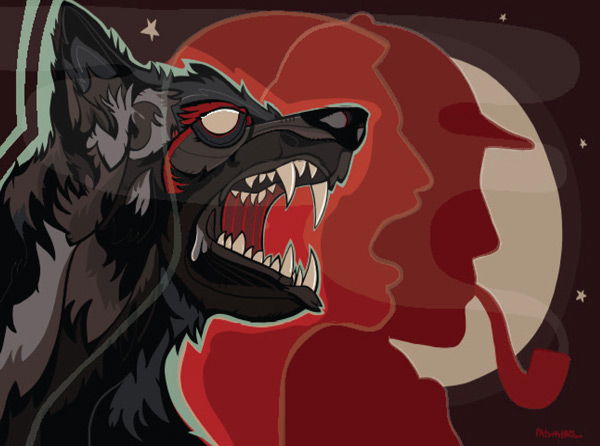Fatspatrol (Fathima) is an Indian-Canadian artist born and raised in Dubai. Her work is a study of symbols and semiotics and our drive to make sense of the world through mythology, folklore and storytelling.
Although there is such a massive array of literature to sift through by Sir Arthur Conan Doyle, I did ultimately settle on The Hound of the Baskervilles. This was a book my brother and I had on our shelf as kids and the cover image of the beast has always stuck with me. I have an attraction to images of ‘darkness’ and a curiosity about why society turns away from them. I thought I’d explore the beast a little more, and find some meaning in what it represents.
In The Hound of the Baskervilles, there’s a strong dichotomy and contrast between two sets of values. Dark vs. Light. Beast vs. Man. Savage vs. Elite. Good vs. Evil. Mystical vs. Scientific. The Moor vs. the City. The Untamed vs. the Civilized. The former being represented by the hound, the moor, the convict, Stapleton, etc. and the latter by the aristocratic. And in a larger context of the time these can also be seen as a reference to racial and class dynamics of the Victorian Era. Eliticism vs. the ‘unwell common folk’. I thought about why darkness poses such a threat, symbolically; we all have the capacity for darkness and to deter from socially determined norms and rationality. We all have an untamed, more primeval self. We all have a beast in us. And in some way, most of us are working to maintain a curated, proper version of ourselves that fits into society’s norms/ requirements/ ideals. Throughout civilization. The threat of the inner beast, of our fear and yet our fascination with darkness and the supernatural.
And so although my first instinct was to draw the man and the beast at odds with each other, face to face, I actually decided to change the orientation so the beast is part of the man and in some sense you see how one can turn into or return from being it. There is some reference to the fog that appears in the book; the fog that blurs our vision momentarily. And as humans we negotiate those boundaries everyday and apply them to larger social divisions. Certainly reading about Sir Arthur Conan Doyle, there seemed to be conflict for him in his scientific self vs. his interest in spiritualism (and therein the dichotomy between him, the author, and his creation Sherlock Holmes). Do we fear the things we fear because we know that we have the capacity to be them, even though they represent the opposite of what we claim to stand for?
Fats.ink IG: @fatspatrol
